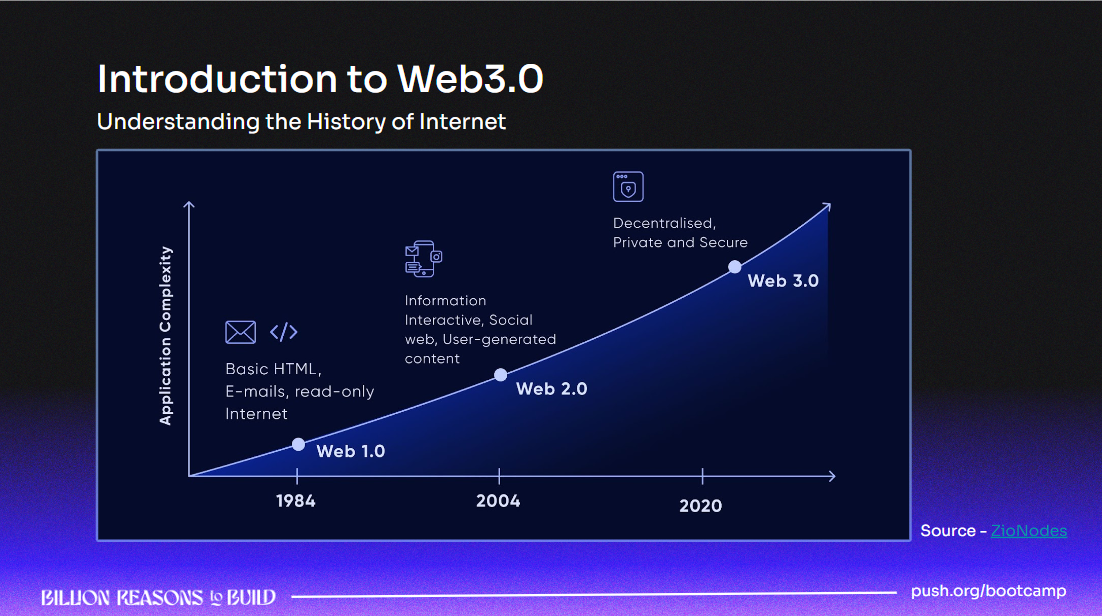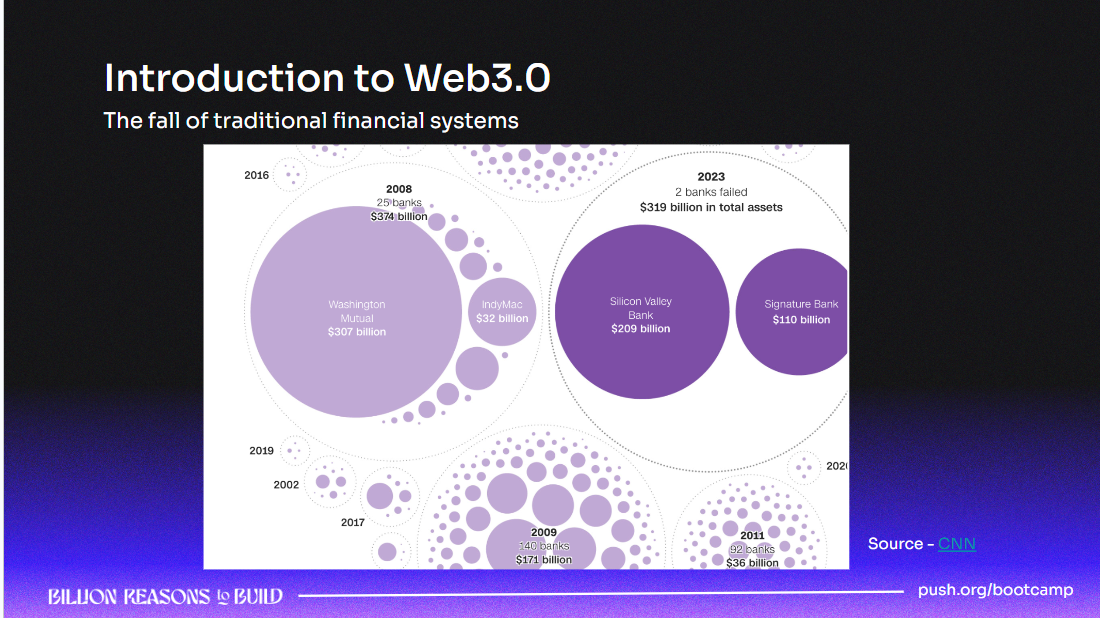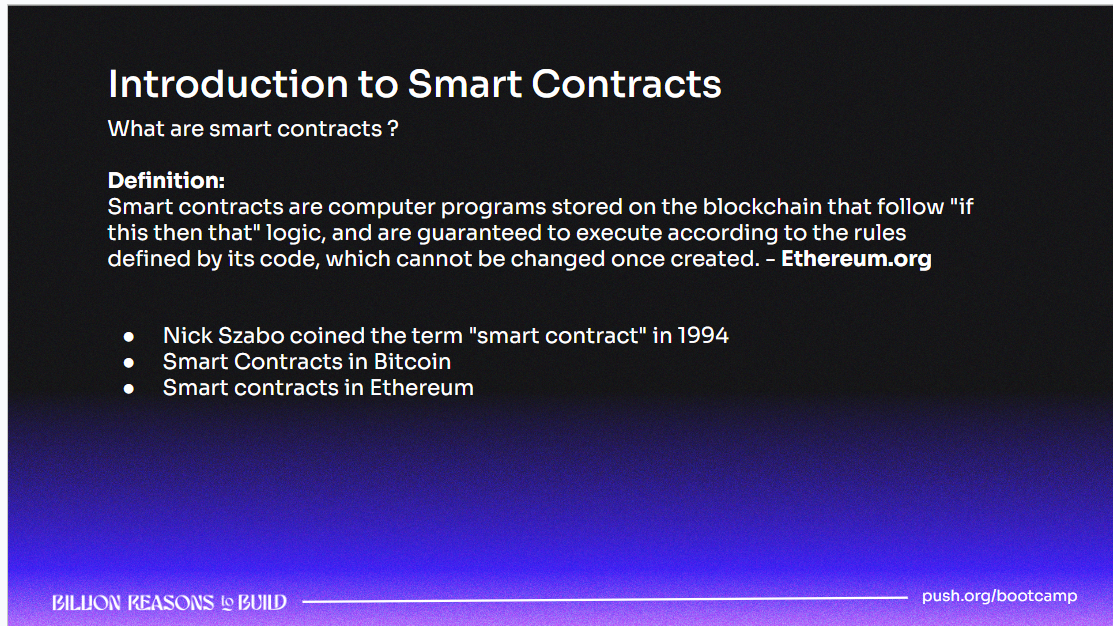Understanding Web3 Fundamentals
 Rajdeep Singha
Rajdeep Singha
INTRODUCTION: First of all we are introduced to the difference between WEB1.O,2.O and 3.O. The lecturer has given us detailed overview of how the technology changes from static to dynamic to decentralization.

KEY LEARNINGS :
Basics of Blockchain Technology
Understanding how data is stored, secured, and validated across a decentralized network:
Data Storage: Blockchain stores data in blocks that are linked together to form a chain. Each block contains a list of transactions and a reference to the previous block, creating an immutable ledger.
Security: Data on the blockchain is secured through cryptographic hashes. Each block contains a hash of the previous block, ensuring that any attempt to alter a block would require changes to all subsequent blocks.
Validation: Transactions are validated by network participants (nodes) through consensus mechanisms, ensuring that only legitimate transactions are added to the blockchain.
Decentralization
Exploring the principles of decentralization and its implications for data privacy, security, and ownership:
Principles of Decentralization: Decentralization means distributing authority and decision-making across a network rather than relying on a central entity. This enhances transparency and reduces the risk of single points of failure.
Data Privacy: Decentralization improves data privacy by eliminating the need for central data storage, reducing the risk of mass data breaches.
Security and Ownership: Users maintain control over their data and assets, reducing dependency on third parties and increasing security against external attacks.
Consensus Mechanisms
Deep dive into various consensus algorithms and their impact on network efficiency, security, and inclusivity:
Proof of Work (PoW): Miners solve complex mathematical puzzles to validate transactions. PoW is secure but energy-intensive and less inclusive due to high computational requirements.
Proof of Stake (PoS): Validators are chosen based on the number of tokens they hold and are willing to "stake." PoS is more energy-efficient and can offer higher inclusivity.
Delegated Proof of Stake (DPoS): Token holders vote for a small number of delegates who validate transactions. This is more scalable but can lead to centralization risks.
Other Mechanisms: Including Proof of Authority (PoA), Byzantine Fault Tolerance (BFT), and newer mechanisms like Proof of History (PoH) and Proof of Burn.
Tokenomics Basics
Exploring the economic models underlying cryptocurrencies and tokens, including supply mechanisms, utility, and value accrual:
Supply Mechanisms: Understanding fixed supply (e.g., Bitcoin) vs. inflationary supply models, and how these impact token value.
Utility Tokens vs. Security Tokens: Utility tokens provide access to services within a blockchain ecosystem, while security tokens represent ownership of an asset.
Value Accrual: How token demand, scarcity, and utility contribute to their market value.
Smart Contracts
Definition: Smart contracts are self-executing contracts with the terms of the agreement directly written into code.
Functionality: They automatically enforce and execute contractual agreements when predefined conditions are met, reducing the need for intermediaries.
Applications: Used in various sectors such as finance, supply chain, and real estate for automating transactions and processes.

Decentralized Applications (DApps)
Overview of DApps, their architecture, and how they differ from traditional applications:
Architecture: DApps run on a blockchain network, utilizing smart contracts for backend logic and decentralized storage solutions for data.
Difference from Traditional Applications: Traditional apps rely on centralized servers, while DApps leverage a decentralized network, enhancing security and user control.
Examples: Cryptocurrency wallets, decentralized exchanges, and blockchain-based games.
Web3 Applications and Innovations
Exploring the advancements and practical applications of Web3 technology, which leverages blockchain for a decentralized internet:
Web3 Characteristics: Focuses on decentralization, user control, and native digital assets.
Innovations: Includes decentralized identity systems, new models for content creation and distribution, and more user-centric data management.
DeFi (Decentralized Finance)
Introduction to the DeFi ecosystem, covering protocols, services, and the shift towards financial decentralization:
Protocols and Services: Includes decentralized exchanges (DEXs), lending platforms, yield farming, and stablecoins.
Benefits: Greater financial inclusion, reduced reliance on traditional banking, and innovative financial products.
Challenges: Regulatory issues, security risks, and liquidity concerns.
NFTs (Non-Fungible Tokens)
Exploring the world of NFTs, and their use cases in digital art, gaming, and beyond:
Definition: NFTs are unique digital assets verified on the blockchain, representing ownership of a specific item or piece of content.
Use Cases: Digital art, collectibles, virtual real estate, in-game items, and intellectual property rights.
Market Dynamics: Influenced by creator popularity, scarcity, and utility in various ecosystems.
DAOs (Decentralized Autonomous Organizations)
Understanding DAOs, their structure, governance, and role in enabling community-driven decision-making:
Structure: DAOs are organizations governed by smart contracts and run by community consensus without centralized leadership.
Governance: Members use tokens to vote on proposals and make decisions collectively.
Role and Impact: Enable democratic governance and transparent decision-making processes, applied in various fields such as investment, charity, and project management.
These elaborations provide a comprehensive overview of key blockchain concepts and innovations, highlighting their significance and applications across various domains.
Conclusion
The exploration of blockchain technology and its various components unveils a transformative landscape poised to redefine numerous aspects of our digital and financial systems. From the foundational principles of decentralization and secure data validation to the innovative applications of smart contracts and decentralized applications (DApps), blockchain presents a paradigm shift towards more transparent, secure, and autonomous systems.
Understanding the nuances of consensus mechanisms sheds light on how blockchain networks achieve trust and security without centralized control, paving the way for more inclusive and efficient digital economies. Tokenomics further complements this ecosystem by introducing sophisticated economic models that drive the value and utility of cryptocurrencies and tokens, fostering new financial paradigms and opportunities.
Smart contracts and DApps exemplify the potential of blockchain to automate and enhance traditional processes, offering seamless, trustless interactions and reducing the need for intermediaries. This shift is further echoed in the rise of Web3, which aims to decentralize the internet itself, empowering users with greater control over their data and digital identities.
The emergence of DeFi (Decentralized Finance) underscores the profound impact of blockchain on the financial sector, enabling unprecedented access to financial services and innovations that challenge traditional banking systems. Similarly, NFTs (Non-Fungible Tokens) revolutionize the concept of digital ownership, creating new markets and opportunities in art, gaming, and beyond.
Decentralized Autonomous Organizations (DAOs) represent the future of organizational governance, embodying the principles of decentralization and community-driven decision-making. DAOs facilitate democratic, transparent management structures that could redefine how organizations operate across various sectors.
In summary, blockchain technology is not merely a disruptive force but a foundational pillar for building more resilient, equitable, and innovative digital infrastructures. Its applications and implications stretch far beyond cryptocurrencies, heralding a new era of decentralized, secure, and efficient systems that have the potential to transform industries and society at large. Embracing and understanding these developments will be crucial for navigating and thriving in the future digital landscape.
Subscribe to my newsletter
Read articles from Rajdeep Singha directly inside your inbox. Subscribe to the newsletter, and don't miss out.
Written by
